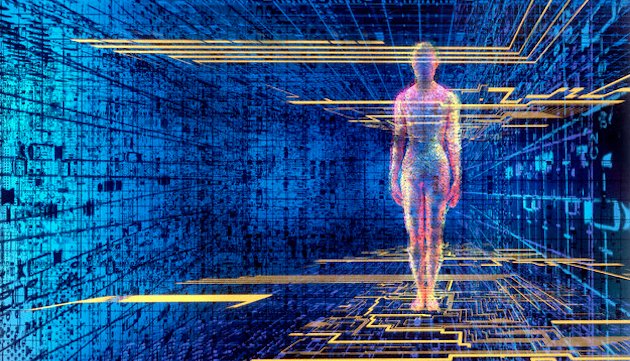
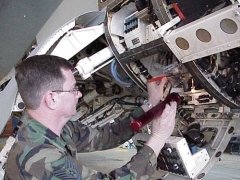 Troubleshooting
complex equipment has traditionally focused on a electronic or
paper manual paradigm. The means to locate information
requires indexes that are searched that then directs a
maintainer to the information he or she needs to begin
troubleshooting a problem. Not only is the accessibility of
the information manual or semi automated, it's also
constrained to a small 2 dimensional format that's either a
page in a paper manual or in a IETM viewed through the screen
of a laptop or tablet. This kind of constraint makes human
cognition of the information gleaned from the manuals very
sequential, slow and overburdening on the maintainer's ability
to focus on multiple potential problem areas.
Troubleshooting
complex equipment has traditionally focused on a electronic or
paper manual paradigm. The means to locate information
requires indexes that are searched that then directs a
maintainer to the information he or she needs to begin
troubleshooting a problem. Not only is the accessibility of
the information manual or semi automated, it's also
constrained to a small 2 dimensional format that's either a
page in a paper manual or in a IETM viewed through the screen
of a laptop or tablet. This kind of constraint makes human
cognition of the information gleaned from the manuals very
sequential, slow and overburdening on the maintainer's ability
to focus on multiple potential problem areas.
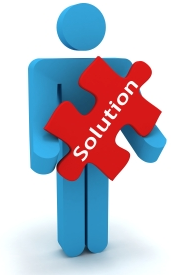 A
good solution to this information overflow, that all
maintainers are subject to, is Augmented Reality. Particularly
Microsoft's HoloLens, where the 2D monitor is no-longer a
constraint and the ability to harness new A.I. capabilities
such as image recognition, allows for automated searches and a
dome field of view that can pin images and/or diagrams! With
the HoloLens areas of an aircraft, ship, field or office can
be recognized where information of systems and their equipment
and even parts can be readily available as the maintainer
looks in any direction. So a series of schematics and their
relevant circuits can be automatically colorized and pinned
across a dome field of view. No need for the maintainer to
manually input through a key board to look for information, no
need for a maintainer to remember specific nomenclature for
any system, equipment or part that is being viewed. The area
and/or equipment can be identified from the HoloLens camera
with AI by simply pointing at it!
A
good solution to this information overflow, that all
maintainers are subject to, is Augmented Reality. Particularly
Microsoft's HoloLens, where the 2D monitor is no-longer a
constraint and the ability to harness new A.I. capabilities
such as image recognition, allows for automated searches and a
dome field of view that can pin images and/or diagrams! With
the HoloLens areas of an aircraft, ship, field or office can
be recognized where information of systems and their equipment
and even parts can be readily available as the maintainer
looks in any direction. So a series of schematics and their
relevant circuits can be automatically colorized and pinned
across a dome field of view. No need for the maintainer to
manually input through a key board to look for information, no
need for a maintainer to remember specific nomenclature for
any system, equipment or part that is being viewed. The area
and/or equipment can be identified from the HoloLens camera
with AI by simply pointing at it!
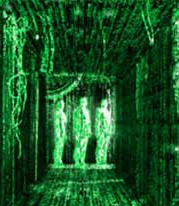 The
potential is endless with Holographic augmented reality
technology. Systems that are compliant with S1000D wiring
documentation can be queried automatically to produce
predictive analytics of related system problems that are
inherently difficult for a human being to identify because of
indirect relationships of many systems and subsystems. Also
consider the ability to share the information in real-time
where the area of concern and the information available can be
viewed by OEM engineers thousands of miles away. Its
astonishing what can be achieved, and realize that machine
intelligence not only can be leveraged to bridge the gap of
varying expertise of maintainers but provides an overwhelming
advantage over any current maintenance paradigm.
With S1000D wiring modules containing the meta-data that
allows for automating data-mining, A.I. can not only identify
equipment but find all potential problem areas and make
recommendations for repairs. Ultimately this realizes in
lowering Mean Time To Repair, shorter training times, and a
higher and flatter performance curve across maintainers, which
directly translates into monetary benefits.
The
potential is endless with Holographic augmented reality
technology. Systems that are compliant with S1000D wiring
documentation can be queried automatically to produce
predictive analytics of related system problems that are
inherently difficult for a human being to identify because of
indirect relationships of many systems and subsystems. Also
consider the ability to share the information in real-time
where the area of concern and the information available can be
viewed by OEM engineers thousands of miles away. Its
astonishing what can be achieved, and realize that machine
intelligence not only can be leveraged to bridge the gap of
varying expertise of maintainers but provides an overwhelming
advantage over any current maintenance paradigm.
With S1000D wiring modules containing the meta-data that
allows for automating data-mining, A.I. can not only identify
equipment but find all potential problem areas and make
recommendations for repairs. Ultimately this realizes in
lowering Mean Time To Repair, shorter training times, and a
higher and flatter performance curve across maintainers, which
directly translates into monetary benefits.
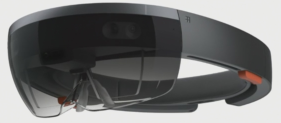 Currently
HoloLens is only available to developers whose application for
development from Microsoft has been approved. Atlas Dynamics'
development application was approved by Microsoft and Atlas
has been in development that will integrate the HoloLens, a
suite of A.I. tools and its point to point publishing and
troubleshooting software suite.
Currently
HoloLens is only available to developers whose application for
development from Microsoft has been approved. Atlas Dynamics'
development application was approved by Microsoft and Atlas
has been in development that will integrate the HoloLens, a
suite of A.I. tools and its point to point publishing and
troubleshooting software suite.